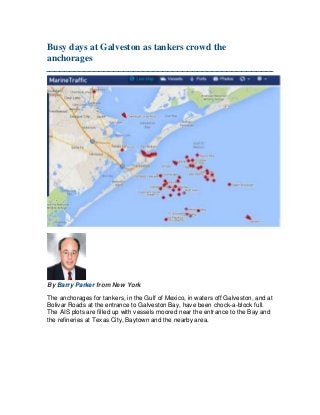Busy days at galveston as tankers crowd the anchorages
A Canadian tanker logistics specialist, Simon Jacques said that a large Canadian oil company was active taking cargo from the U.S Gulf, having fixed one cargo up to East Coast Canada at WS 138 loading Galveston, with another one in the marketplace expected to load at Sunoco Logistics’ facility at Nederland, Texas. Jacques, based in New Brunswick, also said that Castleton Commodities was active in the US Gulf, fixing a light naptha cargo out to Singapore on Heidmar tonnage. The dots on the map are indicative of an energy products network, stretched, at times, beyond its capacity. Los, from CR Weber, continued: “With US Gulf Coast refineries still largely dependent on waterborne imports of heavy crude to offset rising tight light volumes and structural Saudi barrels also remaining, the rise in tanker traffic on the Gulf Coast has proven taxing on the region’s aging infrastructure. This includes not only waterways like the Houston Ship Channel and individual ports like Galveston, but also the tanks which process imports and exports. As a result, we have observed a rise in tanker delays due to shore-side ullage, which occurs when tanks reach their maximum usable capacity.” A question related to buildups of ships at anchor concerns the potential storage of oil in tankers. Jacques hinted that at least part of the fleet at anchor off Texas might be involved in storage activities.

Recommandé
Recommandé
Contenu connexe
En vedette
En vedette (17)
Plus de GE 94
Plus de GE 94 (20)
Busy days at galveston as tankers crowd the anchorages
- 1. Busy days at Galveston as tankers crowd the anchorages By Barry Parker from New York The anchorages for tankers, in the Gulf of Mexico, in waters off Galveston, and at Bolivar Roads at the entrance to Galveston Bay, have been chock-a-block full. The AIS plots are filled up with vessels moored near the entrance to the Bay and the refineries at Texas City, Baytown and the nearby area.
- 2. A condensate cargo, reported to be fixed on BW Zambesi, appears to have been loading Baytown the home of an ExxonMobil complex, for export to Asian buyers. Earnings for MR and LR tankers suitable for the products trades, the predominant vessel size on the AIS charts, have been firming since late June. The Baltic Exchange’s TC14 daily posting, for a Houston - ARA route, typically with a cargo of middle distillate, jumped from $6,000 per day in mid June up as high as $15,000 per day in early July, and in mid month have been bouncing around between $12,000 - $13,000 per day. The shipment of condensate, a very light oil processed sufficiently to be considered a product (OK for export from the US unlike crude oil where exports are mainly prohibited) likely originated in the Eagle Ford fields, a region of Texas where shale oil production has increased exponentially over the past two years. But the explanation for the crowded anchorages encompasses far more. George Los, senior market analyst in the projects group at tanker broker CR Weber & Co. told Seatrade Global: “The number of units anchored off of Galveston is largely indicative of congestion and ullage issues.” Los, an expert on the intersection of the energy and tanker markets, added: “Due to the changing North American energy market driven by the tight oil revolution, a surge in product exports is now being compounded by rising crude exports to Canada, re-exports of Canadian crude and, more recently, rulings which have enabled exports of
- 3. some types of processed condensates.” A Canadian tanker logistics specialist, Simon Jacques said that a large regional Canadian oil company headquartered in the Maritimes was active taking cargo from the U.S Gulf, having fixed one cargo up to East Coast Canada at WS 138 loading Galveston, with another one in the marketplace expected to load at Sunoco Logistics’ facility at Nederland, Texas. Jacques, based in New Brunswick, also said that Castleton Commodities was active in the US Gulf, fixing a light naptha cargo out to Singapore on Heidmar tonnage. The dots on the map are indicative of an energy products network, stretched, at times, beyond its capacity. Los, from CR Weber, continued: “With US Gulf Coast refineries still largely dependent on waterborne imports of heavy crude to offset rising tight light volumes and structural Saudi barrels also remaining, the rise in tanker traffic on the Gulf Coast has proven taxing on the region’s aging infrastructure. This includes not only waterways like the Houston Ship Channel and individual ports like Galveston, but also the tanks which process imports and exports. As a result, we have observed a rise in tanker delays due to shore-side ullage, which occurs when tanks reach their maximum usable capacity.” A question related to buildups of ships at anchor concerns the potential storage of oil in tankers. Jacques hinted that at least part of the fleet at anchor off Texas might be involved in storage activities. Los, discussing larger vessels, said:
- 4. “Regarding floating storage, we have not seen anything to indicate a change from recent norms. The modest contango structure in crude oil markets nearby prices lower than forward prices which emerged recently failed to incite interest in floating storage given the economics of doing so. Securing a VLCCs to service prompt storage contracts off of West Africa would presently cost over $1.10 per barrel per month and in the very tight USG VLCC market that number would likely be over $1.48.” Published inAmericas, Asia, Europe, Port & Logistics, Tankers, Dispatches